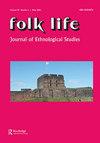Folk belief and landscape in Connacht: accounts from the Ordnance Survey letters
IF 0.1
4区 社会学
0 FOLKLORE
引用次数: 2
Abstract
ABSTRACT The Ordnance Survey of Ireland, carried out in the early-nineteenth century, was not just the process of mapping and collecting place names for translation as it is frequently depicted. The director of the Ordnance Survey, Sir Thomas Colby, decided to also use the Survey to carry out statistical, antiquarian, and geological surveys. The results of this trigonometrical survey include the so-called Ordnance Survey Memoirs and the Ordnance Survey Letters. Both sources provide valuable information about life in Ireland in the 1830s and early 1840s. Focusing in particular on the province of Connacht, this article argues that the Ordnance Survey Letters should be considered an important source of information about folklore and folk beliefs which were still extant or had been until shortly before the Survey visited the locality. This essay examines how, in a period of change and decline, the Ordnance Survey wrote local cultural heritage and identity onto the landscape.康诺特的民间信仰与景观:来自英国军械调查局信件的记述
摘要爱尔兰军械测量局于19世纪初开展,它不仅仅是人们经常描述的绘制和收集地名以供翻译的过程。英国军械调查局局长托马斯·科尔比爵士决定利用该调查局进行统计、古董和地质调查。这项三角测量的结果包括所谓的《军械调查回忆录》和《军械调查快报》。这两个来源都提供了关于19世纪30年代和19世纪40年代初爱尔兰生活的宝贵信息。本文特别关注康诺特省,认为军械调查局信件应被视为民间传说和民间信仰的重要信息来源,这些民间传说和信仰仍然存在或直到调查局访问该地区前不久才存在。本文探讨了在一个变化和衰落的时期,军械测量局是如何将当地文化遗产和身份写入景观的。
本文章由计算机程序翻译,如有差异,请以英文原文为准。
求助全文
约1分钟内获得全文
求助全文
来源期刊
CiteScore
0.30
自引率
66.70%
发文量
17
期刊介绍:
Folk Life: Journal of Ethnological Studies is a journal devoted to the study of all aspects of traditional ways of life in Great Britain and Ireland. The journal publishes original, high quality, peer-reviewed research in the form of unsolicited articles, solicited papers (which are usually selected from those read at the Society"s annual conference) and of members" papers (which are usually short reports of work in progress). Work published in Folk Life may include, for example, papers dealing with the traditional ways of life of other countries and regions, which may be compared to or contrasted with those of Great Britain and Ireland.

 求助内容:
求助内容: 应助结果提醒方式:
应助结果提醒方式:


